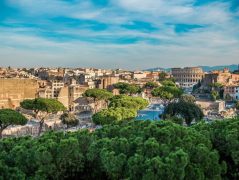
Contents
1 Introduction2 Data and facts3 Administration4 Economy5 Business Environment6 Infrastructure7 Technology8 Social wellness and human resources9 ReferencesIntroduction
Rome is the city capital of Italy and the largest city in the Lazio region. It covers 1,285 square kilometers. The city is perched on the central part of the Italian Peninsula on the Tiber river. The UN World Urbanization Prospects has estimated the population of Rome for the year 2020 as 4,257,056 people. As an intriguing fact, earlier when Emperor Augustus ruled over Rome, it was considered as the largest city in the world providing shelter to approximately 1 million people.
The city lies 24 kilometers far from the Tyrrhenian Sea and has been positioned in the world 13th most tourist visited city by Euromonitor international ranks in the year 2015. The city is a descendant of the prosperous Ancient Roman Empire. Thus, it holds architectural and cultural importance. It is known worldwide for its exemplary exhibition of architecture and as the home of the Roman Catholic Church.
Data and facts
- In 2016 with the estimated population of 4,145,000 people, Rome was the 4th most populated city in the European Union.
- In the year 2017, the real per capita income was estimated to be 43,436 Chained 2012 Dollars
- Among the population of Rome lies about 9.5 % of non-Italian including 4.7 % from European origin and the rest from non-European origins
- For the year 2018, the unemployment rate of the city was recorded as 4.3% and the real GDP for Rome was calculated to be more than 3,787.411 Million of Chained 2012 Dollars.
Administration
The Lazio region is governed by a regional council, committee, and committee president. The law passed by this regional council is enforceable for the whole region. In the city of Rome, the government comprises a communal committee as the executive body, a mayor and a popularly elected communal council. Where the two-round system is employed for the election of Mayor. In 1972 Rome was divided into various administrative areas known as ‘Municipi’. Gradually the number of ‘Municipio’ declined to 15 in the year 2013.
Economy
Although Rome lacks heavy industries, its flourishing banking and tourism industries makes the city’s economy shine. The culture of double employment is quite popular in the city. Yet in 2018 more than 1906 people were employed. Other major industries contributing to the GDP include insurance, engineering, electronics, food processing, chemical industries, printing, publishing, sports, and the movie industry. In the year 2018, the GDP for Rome was calculated as 4,294.954 million dollars. The service sector lies just behind the government as a major employer of the city.
Business Environment
The city of Rome portrays a diverse economy with variegated kinds of businesses (light and medium industries) working together in cooperation to promote the economic welfare of the city. In 2018 the per capita personal income in Rome was totaled to 38,524 Dollars. Businesses in Rome are mainly concentrated in the banking, electronics and aerospace industry. Rome’s prime business district, the Esposizione Universale Roma comprises international headquarters, museums, conference centers, and government ministries. One will find a welcoming business environment built in Rome along with the magnificent work of architecture. The city encourages startups and contributes to their development. The Start-up Act adopted by the Italian government offers various incentives for such early-stage companies.
Infrastructure
In 1955 the Metropolitana, a subway was opened in Rome. Other than this the public transportation is taken care of by an extensive bus system, and the regional and international railways. The city features ring roads and radial patterned secondary arterial roads. In the early 1970s, personal vehicles were banned for reducing air pollution and gradually transportation routes were also diverted to safeguard the prestigious monuments. The city also features 2 major airports namely Leonardo da Vinci Airport and the Ciampino Airport.
Technology
During the Ancient period, Rome was considered as a smart city due to its eco-friendly technological advancements. But the glory lasted only till Republican times. With the entry of modern times, Rome went back to the starting line. Modern Rome has joined the Smart Cities movement. The city aims at using technology as a transparent medium to ensure participation. In the year 2017 Rome organized a Smartathon under the Smarticipate project in order to promote the technology. And since 2018 the city has been implementing the Sustainable Urban Mobility Plan (SUMP). This plan aims at utilizing technology effectively to nurture the environment and develop better infrastructure. Under this plan, all the unused trucks have been refurbished and introduced as hybrid buses. The eternal city is also witnessing a merry concentration of electric bikes and scooters. Rome is aiming to become the smart city with the participation and support of the residents.
Social wellness and human resources
Rome offers both public and private schools with their own pros and cons. The state education is free in Italy from school to university, but for the age of 16 taxes are required. Rome also offers international schools and is open to foreign students. The health care system index of Rome indicates at 58.90. in the health sector also both public and private hospitals are available.
References
https://www.numbeo.com/health-care/in/Rome
https://via.news/mobility/fia-smart-cities-forum-rome-urban/
https://www.expatarrivals.com/europe/italy/rome/healthcare-rome
https://www.public.io/rome-top-10-govtech-startups/
https://www.macrotrends.net/cities/21588/rome/population
https://populationstat.com/italy/rome
https://www.comune.roma.it/TERRITORIO/nic-gwt/
https://www.comune.roma.it/web/it/sistema-informativo-territoriale-nic.page
https://worldpopulationreview.com/world-cities/rome-population/
https://www.britannica.com/place/Rome/People#ref23879
https://en.wikipedia.org/wiki/Rome#Government
https://www.worldscapitalcities.com/capital-facts-for-rome-italy/
https://www.datacentermap.com/italy/rome/
https://simple.wikipedia.org/wiki/Rome#Education
https://www.reuters.com/article/us-italy-rome-idUSKCN0PP0SF20150715
https://www.historyoftheancientworld.com/2015/05/why-republican-rome-was-a-smart-city/
https://www.fia.com/news/smart-cities-forum-rome
https://cities-today.com/the-eternal-city-goes-digital/
https://www.smarticipate.eu/by-the-public-for-the-public-romans-help-to-shape-smarticipate/
https://www.geosociety.org/gsatoday/archive/25/5/pdf/i1052-5173-25-5-4.pdf
https://romabyrachel.weebly.com/rome-today.html
https://www.crystalinks.com/romescience.html
https://www.forbes.com/sites/miltonezrati/2019/06/27/danger-from-rome/#58bbc4a35217
https://www.newworldencyclopedia.org/entry/rome#Economy
http://www.aboutroma.com/economy-rome.html
https://en.wikipedia.org/wiki/Economy_of_Rome
 Metricsbeta
Metricsbeta